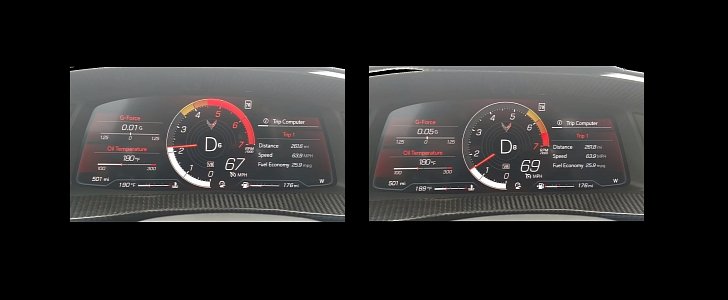Chevrolet says the first 500 of 1,500 miles of break-in are the most important for the C8 Corvette. During these 800 kilometers or so, torque is limited in lower gears and engine speeds exceeding 4,000 revolutions per minute are not recommended for obvious reasons.
Chevrolet further makes a point about avoiding constant speeds, fast or slow, including the use of cruise control. In addition to the odometer reading 500 or more miles, this initial phase of the break-in period is officially over when the tachometer changes the redline from 4,500 to 6,500 rpm. The question is, what happens next until 1,500 miles?
In the owner’s manual, pages 162 and 163 provide the answer, as follows: “Do not participate in track events, sport driving schools, or similar activities. Check engine oil with every refueling and add if necessary. Oil and fuel consumption may be higher than normal.”
Speaking of the oily bits, draining the oil and changing the oil filter is pretty easy. You can find out how easily from the Chevy Dude.
There’s no denying that driving the C8 as Chevrolet recommends you to do is particularly hard in the first 1,500 miles of the vehicle, more so when you hear the LT2 fire up to life, singing the song of its people through the sports exhaust of the Z51 Performance Package. The $5,000 option also unlocks 5 more horsepower and 5 more pound-feet.
On the dyno, a non-Z51 with less than 30 miles on the odometer is much obliged to deliver 440 horsepower and 408 pound-feet of torque to the rear wheels. Considering the crankshaft ratings of 490 horsepower and 465 pound-feet, you’re looking at drivetrain losses of 10.3 and 12.3 percent. Both estimates are well within the 15-percent rule.
As opposed to the C7 Stingray, the C8 Stingray improves the small-block formula with a revised cam profile and phasing, dry-sump lubrication, different cylinders deactivating (2, 3, 5, 8 instead of 1, 4, 6, and 7), and a ground-up exhaust redesign with 330-mm runners.
In the owner’s manual, pages 162 and 163 provide the answer, as follows: “Do not participate in track events, sport driving schools, or similar activities. Check engine oil with every refueling and add if necessary. Oil and fuel consumption may be higher than normal.”
Speaking of the oily bits, draining the oil and changing the oil filter is pretty easy. You can find out how easily from the Chevy Dude.
There’s no denying that driving the C8 as Chevrolet recommends you to do is particularly hard in the first 1,500 miles of the vehicle, more so when you hear the LT2 fire up to life, singing the song of its people through the sports exhaust of the Z51 Performance Package. The $5,000 option also unlocks 5 more horsepower and 5 more pound-feet.
On the dyno, a non-Z51 with less than 30 miles on the odometer is much obliged to deliver 440 horsepower and 408 pound-feet of torque to the rear wheels. Considering the crankshaft ratings of 490 horsepower and 465 pound-feet, you’re looking at drivetrain losses of 10.3 and 12.3 percent. Both estimates are well within the 15-percent rule.
As opposed to the C7 Stingray, the C8 Stingray improves the small-block formula with a revised cam profile and phasing, dry-sump lubrication, different cylinders deactivating (2, 3, 5, 8 instead of 1, 4, 6, and 7), and a ground-up exhaust redesign with 330-mm runners.





















